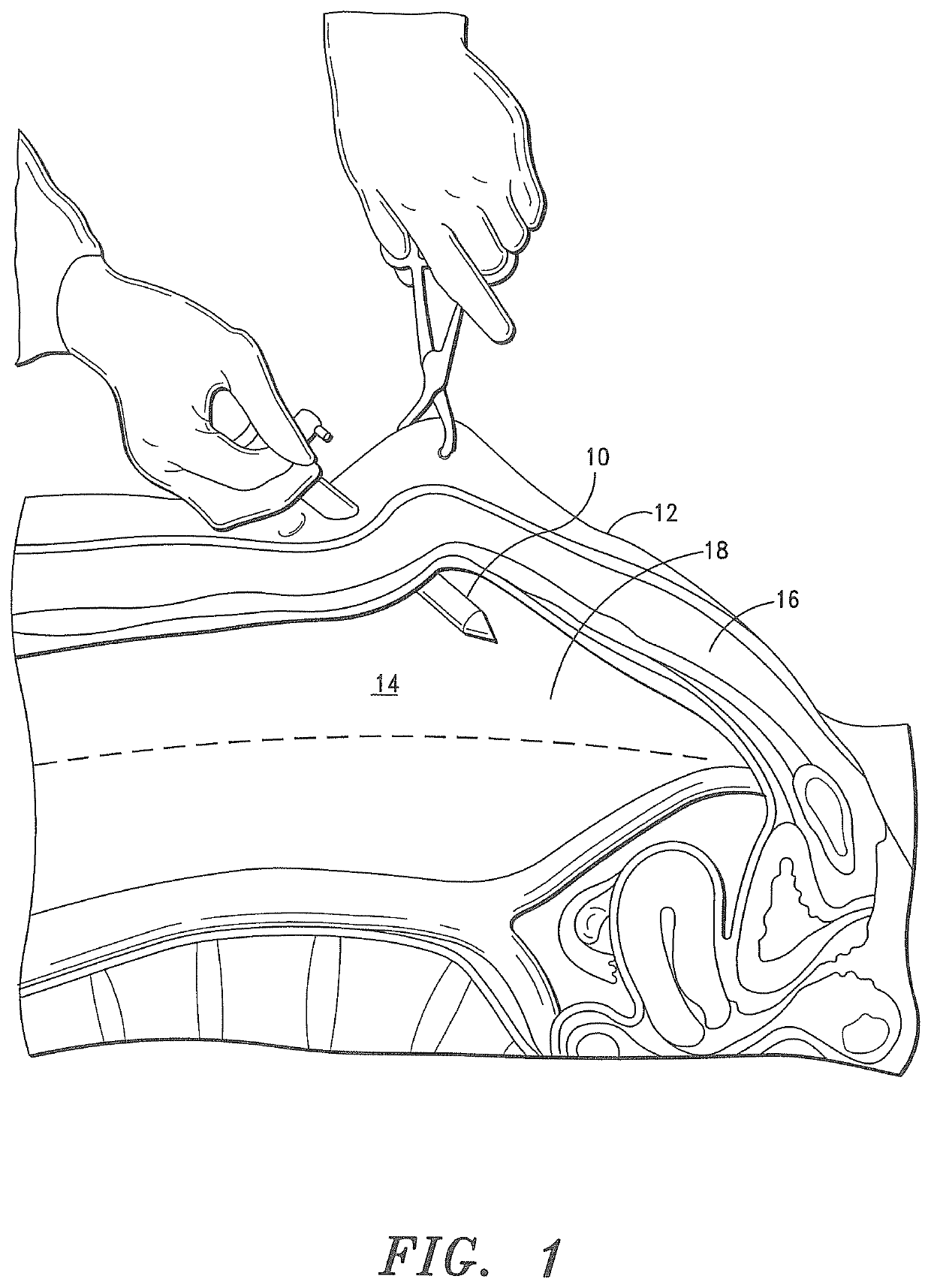It is believed that inadequate closure of the trocar access portal is the primary cause of trocar-site hernias.
Although the noted methods can, in most instances, be employed to successfully close a trocar access portal, there are several significant drawbacks and disadvantages associated with the methods.
Indeed, as discussed below, most, if not all, current trocar access portal closing methods are typically difficult to perform, require considerable time to execute and do not provide for a simple, reproducible and reliable means of closing the trocar access portal.
A major drawback and
disadvantage associated with the disclosed methods is that the apparatus and methods are primarily dependent on the dexterity of the surgeon operating the apparatus and executing the associated methods.
A further
disadvantage associated with the methods disclosed in U.S. Pat. Nos. 919,138, 3,946,740 and 4,621,640 is that the surgeon operating the apparatus associated with the methods must either perform the trocar access portal closure “blind”, i.e. without visual access to interior body tissues, e.g. intra-abdominal
fascia, or with the assistance of an
endoscope inserted into the
body cavity from an additional access portal.
A further
disadvantage is that an exposed needle must be handled by a surgeon inside of a
body cavity with limited visual access, thus, which increases the risk of injury to the local structures inside of a patient, e.g. organs.
A further disadvantage associated with the apparatus and methods disclosed in U.S. Pat. Nos. 919,138, 3,946,740 and 4,621,640 is that, if the surgeon desires to place more than one suture throw through the tissue, the surgeon must reload the needle into a needle driver apparatus.
This process is
time consuming and oftentimes a frustrating exercise in hand-to-eye coordination.
Another drawback associated with the apparatus and associated methods disclosed in U.S. Pat. Nos. 919,138, 3,946,740 and 4,621,640 is that the apparatus can, and often times will, fail to effectively close tissue that is disposed
proximate the trocar access portal, which greatly increases the patient's risk of trocar-site herniation at the closure site.
The seminal complications associated with trocar-site herniation include organ
necrosis and
closed loop intestinal obstruction, which can be life-threating.
A further drawback is that patients with relatively thick body tissues increase the difficulty, time and risk of trocar access portal closure complications, such as a misplaced suture and / or penetration of a patient's organs with the suture needle.
A major drawback and disadvantage associated with the methods disclosed in U.S. Pat. No. 8,109,943 and Pub.
No. 2016 / 0228107 is that the stitch produced does not encompass the anterior
fascia and
peritoneum and, hence, does not fully close the defect in a traditional manner.
A further drawback associated with the methods disclosed in U.S. Pat. No. 8,109,943 and Pub.
No. 2016 / 0228107 is that, even if the
trocar device is appropriately positioned in a patient, there is no means to ensure that the anchors will completely penetrate the targeted body tissues and successfully close the trocar access portal.
A further drawback is that at least two (2) exposed
suture needles must be handled by a surgeon inside of a patient's
body cavity with limited visual aid, which, as indicated above, greatly increases the risk of injury to the local structures, e.g. organs.
Another drawback associated with the apparatus and methods disclosed in U.S. Pat. No. 8,109,943 and Pub.
There is also a substantial risk of dislodgment of the
suture anchors from
body tissue, which can also cause serious postoperative complications.
Several drawbacks and disadvantages are similarly associated with the Medtronic® device and associated method.
A major drawback and disadvantage is that there is no reliable means associated with the Medtronic® device for a surgeon to assess whether the device is properly positioned in (or through) the
body tissue of a patient.
It is, however, very difficult, if not impossible to achieve proper
trocar device positioning for every patient via the fixed circumferential bands due to varying
body tissue thicknesses encountered from patient-to-patient.
As a result of inaccurate positioning of the Medtronic® device, the associated method can cause unintended damage or trauma to local tissues.
The Medtronic® method can also fail to successfully close a trocar access portal, which can lead to the above noted complications, e.g. trocar-site herniation.
A further drawback associated with the Medtronic® method is that the method requires a secondary grasper tool controlled from an additional trocar access portal in order to guide a suture through the two (2) contra-laterally opposed regions of body tissue.
A further drawback associated with the Medtronic® method is that it is extremely difficult and cumbersome to manipulate and engage the intra-cavity suture with the grasper tool.
Another drawback associated with the Medtronic® method is that the method also requires that at least one (1) sharp instrument be introduced to and manipulated within a body cavity with limited visual access to interior body tissues, which as indicated above, substantially increases the risk of injury to the local structures inside of a patient, e.g. organs.
 Login to View More
Login to View More  Login to View More
Login to View More 


